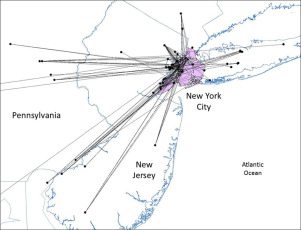Science of the Total Environment ( IF 8.2 ) Pub Date : 2018-09-22 , DOI: 10.1016/j.scitotenv.2018.09.284 Daniel Walsh , Isabel McRae , Ryan Zirngibl , Shaminder Chawla , Horace Zhang , Alysha Alfieri , Hannah Moore , Caleb Bailey , Anna Brooks , Tara Ostock , Sarah Pong , Taylor Hard , Colin Sullivan , John Wilding

|
With increasing urgency to build earthworks projects to protect against flooding from climate change and mitigate exposure to pollutants in degraded urban soils, many cities could experience increased demand for soil of between 10 and 35 million t in coming decades. This study showed that building construction in New York City (NYC) produces an estimated 1.7 × 106 t of surplus clean native soil (mostly glacial sediments) each year and could be an important source to meet future urban soil demand. This quantity of soil is sufficient to build a 3-m-high earthen levee 21-km long each year and a continuous levee along NYC's 840 km shoreline in about 40 years. Alternately, this quantity is sufficient to build a 15-cm-thick clean soil cover over 7.3 km2 of degraded urban soil each year. Detailed study of the fate of 1.03 × 106 t of surplus soil from 113 building construction projects showed that over 95% was exported, with average one-way soil transportation of about 72 km. Paradoxically, while >74% of soil was recycled, long transportation through a diffused network of recycling facilities caused significant environmental and economic impacts. Each year, surplus soil management from building construction in NYC requires an estimated 60,000 truck-trips and 8.7 × 106 km of truck travel, combusts 4.3 × 106 l of fossil fuel, emits 11,800 t of CO2 and costs over $60 M. Soil banking and other programs and public policies to retain soil within cities could increase urban soil supply to meet the rising demand for earthworks projects while also reducing soil transportation and associated environmental and economic impacts and achieving circular urban materials metabolism goals.
中文翻译:

纽约市提取的剩余土壤的产生率和命运
随着建设土方工程以抵御气候变化带来的洪灾和减轻城市退化土壤中污染物暴露的紧迫性,在未来几十年中,许多城市对土壤的需求将增加10到3500万吨。这项研究表明,纽约市(NYC)的房屋建筑每年估计会产生1.7×10 6 吨的过剩清洁原生土壤(主要是冰川沉积物),并且可能是满足未来城市土壤需求的重要来源。如此大量的土壤足以每年建造一个21米长的3米高的土堤,并在约40年的时间里沿着纽约市840公里的海岸线连续修建堤坝。或者,此数量足以在7.3 km 2的范围内建造15厘米厚的干净土壤覆盖层每年退化的城市土壤的数量。对 113个建筑项目的1.03×10 6 t剩余土壤的命运进行的详细研究表明,出口量超过95%,平均单向土壤运输量约为72 km。矛盾的是,尽管> 74%的土壤被回收,但通过分散的回收设施网络进行的长时间运输却对环境和经济产生了重大影响。每年,纽约市建筑施工产生的多余土壤管理估计需要60,000辆卡车行程和8.7×10 6 km的卡车行程,燃烧4.3×10 6 l的化石燃料,排放11,800 t CO 2 以及超过6,000万美元的成本。在城市内保留土壤的土壤储备和其他计划以及公共政策可能会增加城市土壤供应,以满足对土方工程不断增长的需求,同时还能减少土壤运输以及相关的环境和经济影响,并实现循环的城市物质新陈代谢目标。






























 京公网安备 11010802027423号
京公网安备 11010802027423号